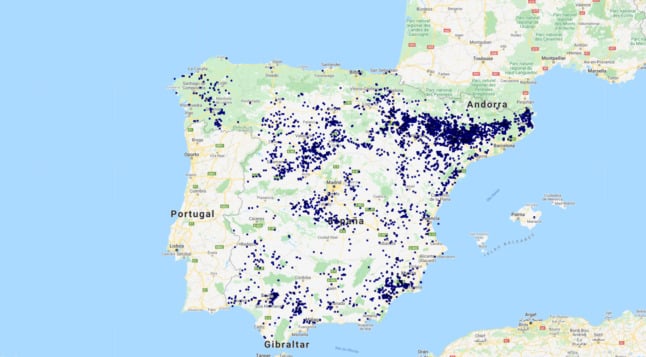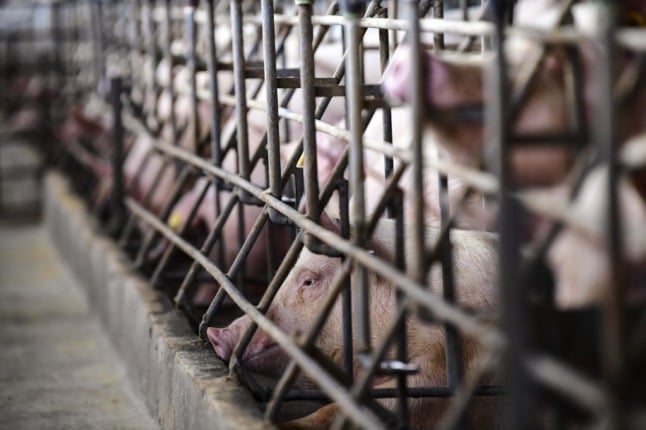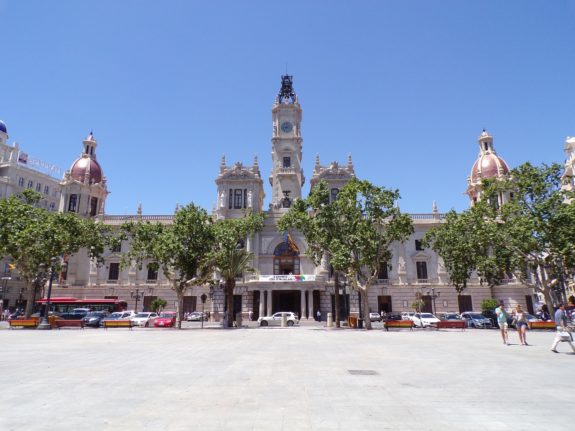At least 7,100 mega farms
Mega farms, called macrogranjas in Spanish, isn’t an officially recognised word yet but has been coined by environmental groups to refer to intensive livestock facilities that house thousands of penned-in animals in an enclosed facility.
In many ways they resemble a factory with an assembly line rather than a farm where livestock can roam free.
According to Spain’s State Register of Pollutant Emissions and Sources (PRTR), there are 7,100 industrial facilities of this nature across Spain.
A total of 53 percent of them – 3,392 – are large-scale poultry and pig facilities, with tens of thousands more small and medium farms accross the country.
As things stand, cattle farms in Spain do not have to report emissions to the PRTR, something the Spanish government is reportedly working on changing.
There are 69,126 farms rearing calves in Spain, but only 3,730 of them have more than 100 cows.
There isn’t an official figure to determine when a farm becomes a mega farm, but pig farms with more than 750 pigs and poultry facilities with more than 40,000 birds have to report their emissions.
What’s the problem with mega farms?
In an article in early January in The Guardian, Spain’s Consumer Affairs Minister Alberto Garzón said: “what isn’t at all sustainable is these so-called mega farms. They find a village in a depopulated part of Spain and put in 4,000, or 5,000 or 10,000 head of cattle”.
“They pollute the soil, they pollute the water and then they export this poor-quality meat from these ill-treated animals”.
His comments have caused an uproar from the Spanish meat industry, other politicians and from senior members of the ruling Socialists, causing divisions in Spain’s coalition government.
But was Garzón right? The minister was referring to mega farms in particular, not those with more sustainable models.
From 2007 to 2020, pork production increased by 36 percent in Spain, which is the biggest pork products exporter in the world.
Last December, the EU took Spain to court for violating the limits for nitrate pollutants in water and soil caused by agro-livestock waste.
The recent environmental disaster in Murcia’s Mar Menor, where thousands of dead fish washed up on Spain’s southeastern coastline, is scientifically proven to have been largely caused by intensive farming and the ensuing eutrophication, an environmental hazard that causes aquatic ecosystems to collapse due to a lack of oxygen in the water.
READ MORE: Five stats to understand why Spain’s Mar Menor is full of dead fish
One of the other main impacts of large-scale intensive livestock farming is the emission of methane, a gas with a greenhouse effect potential about 20 times greater than CO2 according to the UN.
Spain’s mega farms produced 99 million kilos of methane in 2020, according to PRTR data.
Spain has also failed to comply with the EU’s emission limits of ammonia into the atmosphere from 2010 to 2019.
In theory, all farms in Spain that exceed the PRTR’s emission levels need to report this and get a specific authorization and environmental impact statement to continue operating.
But the discontent and concern among Spain’s rural communities is palpable, with many residents demanding an end to intensive pig farming and fearing the impact on groundwater and on their quality of life from untreated manure from the animals.
And for the animals themselves, mega farms mean a horrible life trapped indoors with often only one square metre per pig, unhealthy living conditions which cause disease, stress, cannibalism and pre-mature death.
READ MORE: Spain’s countryside rises up against ‘pig factories’
Where are Spain’s mega farms?
The three regions in Spain where the majority of ‘macro farms’ intended for the intensive rearing of poultry or pigs are Aragón (922), Catalonia (856) and Castilla y León (582), all in the northern half of the country.
In Catalonia, 41 percent of aquifers are contaminated by animal waste and 142 municipalities suffer from water supply problems. In Aragón, the water of 18 percent of municipalities is contaminated by pig waste.
Of the 115 large dairy farms across Spain, 32 are in Catalonia, 19 in Castilla y León, 12 in Castilla-la Mancha and 11 in Navarra.

The largest farms for rearing cows for meat production are in Castilla y León (1,268) and Extremadura (1,157).
Livestock farming is responsible for some 2.5 million jobs in the country and accounts for €9 billion ($10 billion) in annual exports, according to the United Nations’ Food and Agriculture Organization (FAO).



 Please whitelist us to continue reading.
Please whitelist us to continue reading.
Member comments